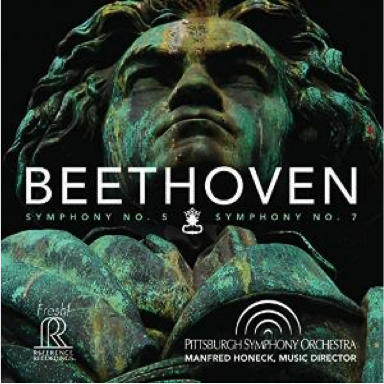Beethoven: Symphonies 5 & 7

Beethoven: Symphonies 5 & 7, Pittsburgh Symphony Orchestra conducted by Manfred Honeck. Reference Recordings
FR-718SACD
If you do a search on “Beethoven symphony 5”, Amazon’s dubious search engine delivers twenty pages of hits. I haven’t checked this out, but since the first page lists sixteen, a total of over three hundred is implied. Some of these are no doubt duplicate performances on different labels, some are simply redundant, some perhaps don’t belong there at all, but any way you figure it, the Fifth is demonstrably Beethoven’s most popular and ubiquitous composition. I cut my aesthetic teeth on this symphony. I can remember as a child standing in the living room of our house in New Jersey listening to an early vinyl disc, in ultra-low fidelity, on my father’s patchwork record player. Side one was Tchaikovsky’s Swan Lake. Side two was Beethoven’s Fifth. (Being used to 78s, I found it amazing that so much music could be put on a single disc.) Conductor and orchestra were unnoted, and unnoteworthy. Everest Keene and the Camden Philharmonia, or some such improbable pairing.
Like all aficionados of my longevity, I have heard numerous versions of the Fifth over the years, but when I alighted on Carlos Kleiber’s performance on the Deutsche Grammophon label, a decade or two ago, I stopped looking. Kleiber in my opinion is one of the supreme conductors of the Twentieth Century and every time I listened that CD, I emerged astonished. It simply didn’t get any better. No other version I’d heard before or since held a candle to it.
Till now.
I was floored from the first bar of the Allego ma non troppo. Speaking of tempo, there are doubtless literalists out there for whom the letter of the law (Fast but not too much) is more important than the spirit. I wish them well, I wouldn’t dream of trying to change their minds. All I can say is that Maestro Honeck’s temporal conception of this symphony, which is quite fast, is so spot on, it makes what remains of my hair stand on end. I was literally lost for words. Once I managed to speak at all, I could only say, This is the greatest Fifth I’ve ever heard. Not a typical reaction for me. By nature I’m chary of hyperbole and I avoid absolutes like the plague they are. I offer my comment not because I am prepared to defend it in the lists, but because it conveys something of the intensity of my emotions.
And the clarity and control! The members of the PSO must love working with this conductor. It is apparent that he demands a lot of his musicians, and that they give it to him with knobs on. It is rare, very rare, to hear a large ensemble of musicians play with such impeccable precision and passion. I was immediately reminded of a little-known recording of Mahler’s Fifth (!) with Rudolf Barshai conducting the Junge Deutsche Philharmonie, teenage musicians from all over Germany, full of excitement and spontaneous passion that is virtually never encountered in grown-up, professional musicians. It may be no coincidence that that recording and this have in common a live audience. This is it, the lead clarinet whispers to the French horn, one shot only. I’ve mentioned before that there’s often something special about live performances. This is a Fifth that, like Kleiber’s, will go down in history.
In the Seventh, as I always so, I concentrated on the Allegretto because it has long been my favorite movement of this symphony. I know, I know: you’re supposed to listen to the entire work every time; I mean, that’s what the composer intended, no? But in recent years I’ve become selfish with my time and I care less for following the rules of aesthetic etiquette than I do for particular aesthetic pleasures. And this Allegretto proffers riches for our delectation, emotionally, melodically, rhythmically. I’ve never heard a version quite like this. In it’s wake it leaves the sense of excitement and fulfillment that arise when aesthetic intelligence is combined with great heartedness.
The two movements I’ve referenced have in common a noted Beethoven characteristic, a theme of great economy and simplicity, or as one critic put it, a “dry stick” of a theme. The second movement of the Seventh is hardly a theme at all, just simple rhythmic variation on simple harmonies. More than any other composer, Beethoven could reach deep inside himself to the universal, the essential humanity we all share, and could express this directly and unpretentiously. He leaves an indelible impression of unflinching honesty on nearly everyone who hears him. Beethoven once said that if you understand his music you will be free of the suffering of the world. If there is monumental conceit here, there is also a profound truth. In the vast genealogy of European composers, each of whom is unique, and many of whom are profound and wonderful, Beethoven stands out.
I hope I have said enough to encourage you to buy this disc. Like every Reference Recordings disc I’ve heard, the sound quality is superb, microphone placement impeccable. And if you’re lucky enough to have an SACD setup (which I do not), you’re in business because this is a dual-layer disc.


Russell Lichter
Stereo Times Masthead
Publisher/Founder
Clement Perry
Editor
Dave Thomas
Senior Editors
Frank Alles, Mike Girardi, Russell Lichter, Terry London, Moreno Mitchell, Paul Szabady, Bill Wells, Mike Wright, and Stephen Yan,
Current Contributors
David Abramson, Tim Barrall, Dave Allison, Ron Cook, Lewis Dardick, John Hoffman, Dan Secula, Don Shaulis, Greg Simmons, Eric Teh, Greg Voth, Richard Willie, Ed Van Winkle, Rob Dockery, Richard Doran, and Daveed Turek
Site Management Clement Perry
Ad Designer: Martin Perry





Be the first to comment on: Beethoven: Symphonies 5 & 7